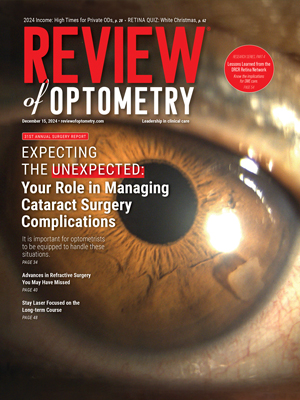|
Measuring the change of anisocoria status in the early re-dilation phase aids in the diagnosis of Horner’s syndrome even without pharmacological testing in patients evaluated for anisocoria. Photo: Nick Karbach, OD. Click image to enlarge. |
Differentiating Horner’s syndrome from physiological anisocoria is important, as newly diagnosed Horner’s can be the first sign of a possibly life-threatening condition. This is challenging, however, because in both cases the anisocoria increases in the dark and other signs of Horner’s are not always present. In a recent study, authors investigated the diagnostic accuracy of pupillometry to discriminate the two conditions compared to pharmacological testing with apraclonidine. They found diagnostic accuracy indicating that pupillometry yields robust measurements, especially after calculating the change of anisocoria after three to four seconds of darkened lighting conditions. The team’s paper on the work was recently published in Journal of Neuro-Ophthalmology.
A total of 44 patients, mostly referred for evaluation of anisocoria, were included. Automated binocular pupillometry was performed under standardized light conditions before and 0.30 minutes after instillation of 1% apraclonidine drops. A positive apraclonidine test indicating Horner’s syndrome was defined as an increase of pupil size in the smaller pupil and decrease of size in the larger pupil. Receiver operator characteristic curves (a measure of the strength of association between two variables) were calculated to find the best pupillometric parameter discriminating Horner’s from physiological anisocoria.
It was found that pupillometry could reliably discriminate Horner’s from physiological anisocoria compared to apraclonidine testing and can be a useful tool for evaluation of anisocoria, especially in situations when pharmacological testing should be used with caution, such as patients on surveillance units, pregnant patients or in acute-onset Horner’s syndrome where pharmacological hypersensitivity may not have yet developed.
Calculating the change of anisocoria at three to four seconds after lights-off relative to the anisocoria at the end of the lights-on period may be most suitable to rule out Horner’s, reaching a sensitivity of 95% and specificity of 68% using a cutoff of 0.35mm.
The technique offers several advantages over other methods. “First, measurement in the early dilation phase saves time and thus reduces the risk of blink and movement artifacts, which are more likely to occur in late measurements,” the authors wrote. “Second, measurements relying on velocity traces have the problem that the differentiation of the pupil diameter signal makes them more sensitive to noisy data.”
The anisocoria increased after lights-off in both the Horner’s and physiological anisocoria group and was greater in dark than in light. The average maximum anisocoria in the Horner’s group barely exceeded 1mm in this study, as noted in previous reports. “The maximum anisocoria in Horner’s syndrome appears earlier than in physiological anisocoria, meaning the anisocoria needs to be observed in the early dark adaptation phase,” the authors wrote. “Hence, a purely clinical differentiation of Horner syndrome from physiological anisocoria by assessing pupil size in light and dark is challenging.”
The relatively low specificity of pupillometry in this study may be owed to the authors’ definition of a positive apraclonidine test that required the affected pupil to become larger and the normal pupil to become smaller. “Generally, the apraclonidine test is considered positive when it produces a reversal of anisocoria. However, there may be equivocal results when the affected pupil gets larger, and the nonaffected pupil gets smaller but not enough to result in a reversal,” the authors wrote. “This led us to define a positive test as an increase of pupil size of the smaller pupil larger than the decrease of size of the bigger pupil.”
Neither the authors’ definition of a positive apraclonidine test nor the pupil dilation metrics are useful to find binocular Horner syndrome, as they both rely on a healthy pupil in the fellow eye, they continued.
“Given that pupillometry failed to diagnose only one of the apraclonidine-positive cases, pupillometry appears to work well at detecting even small potential sympathetic deficits,” the authors concluded.
| Click here for journal source. |
Disse LR, Bockisch CJ, Weber KP, Fierz FC. Differentiation of Horner syndrome and physiological anisocoria by automated pupillometry. J Neuro-Ophthalmol. November 8, 2025. [Epub ahead of print.] |


